Impact of Work-life Balance, Flexibility & Commitment on Performance
VerifiedAdded on 2023/06/08
|27
|13357
|192
Thesis and Dissertation
AI Summary
This thesis investigates the relationship between work-life balance, workplace flexibility, organizational commitment, and employee performance within the Indian financial sector. The study utilizes both primary and secondary research to identify factors influencing work-life balance, such as job engagement and flexible work schedules. Through quantitative analysis, it assesses the impact of these factors on employee performance, considering parameters like age, gender, working hours, and job satisfaction. The research aims to provide insights for financial sector management to improve policies and strategies related to work-life balance, flexibility, and commitment, ultimately reducing employee turnover and enhancing overall organizational performance. The study concludes with implications for theory, methodology, leadership, management practices, and public policy, while also acknowledging limitations and suggesting future research directions.
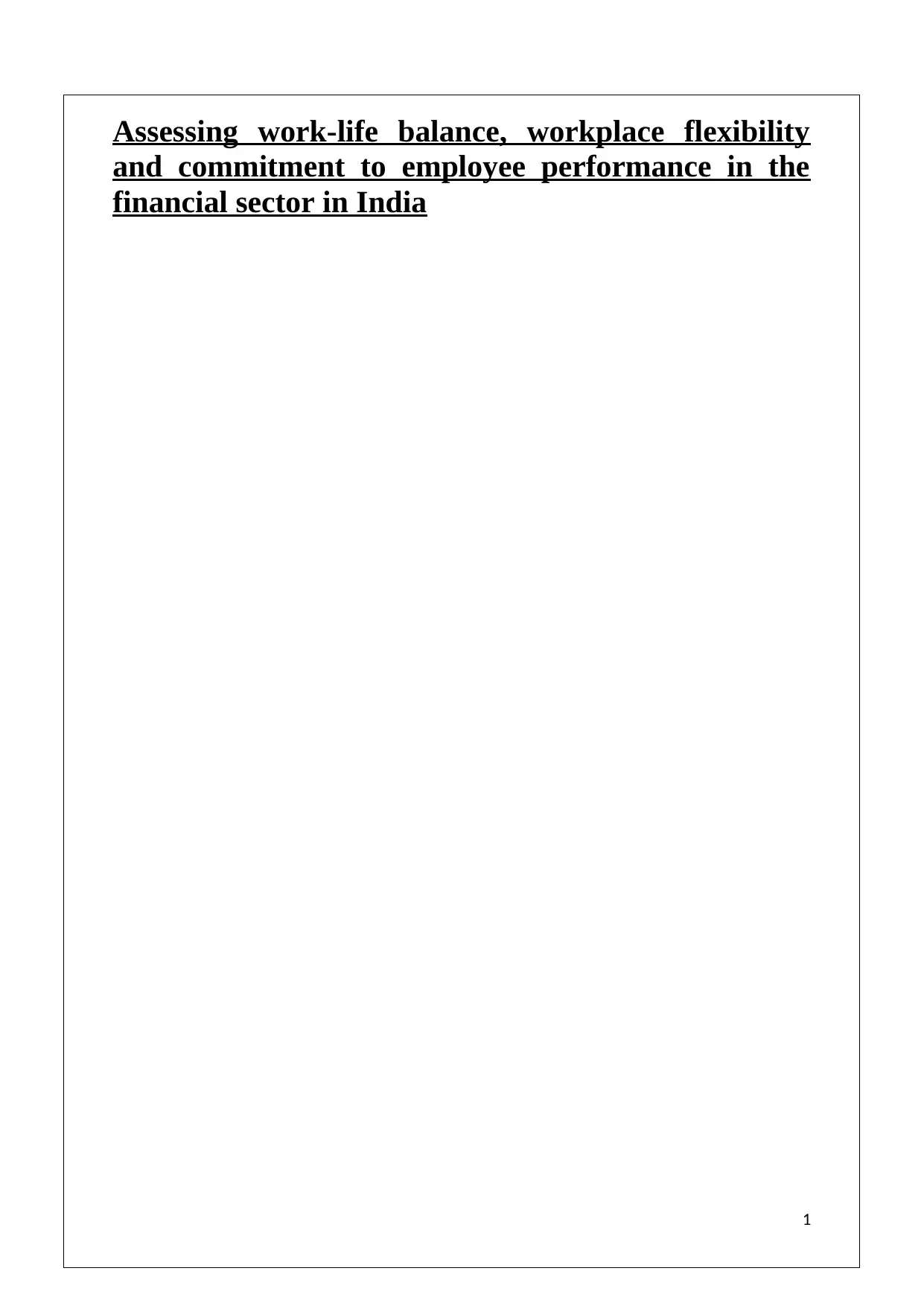
Assessing work-life balance, workplace flexibility
and commitment to employee performance in the
financial sector in India
1
and commitment to employee performance in the
financial sector in India
1
Paraphrase This Document
Need a fresh take? Get an instant paraphrase of this document with our AI Paraphraser
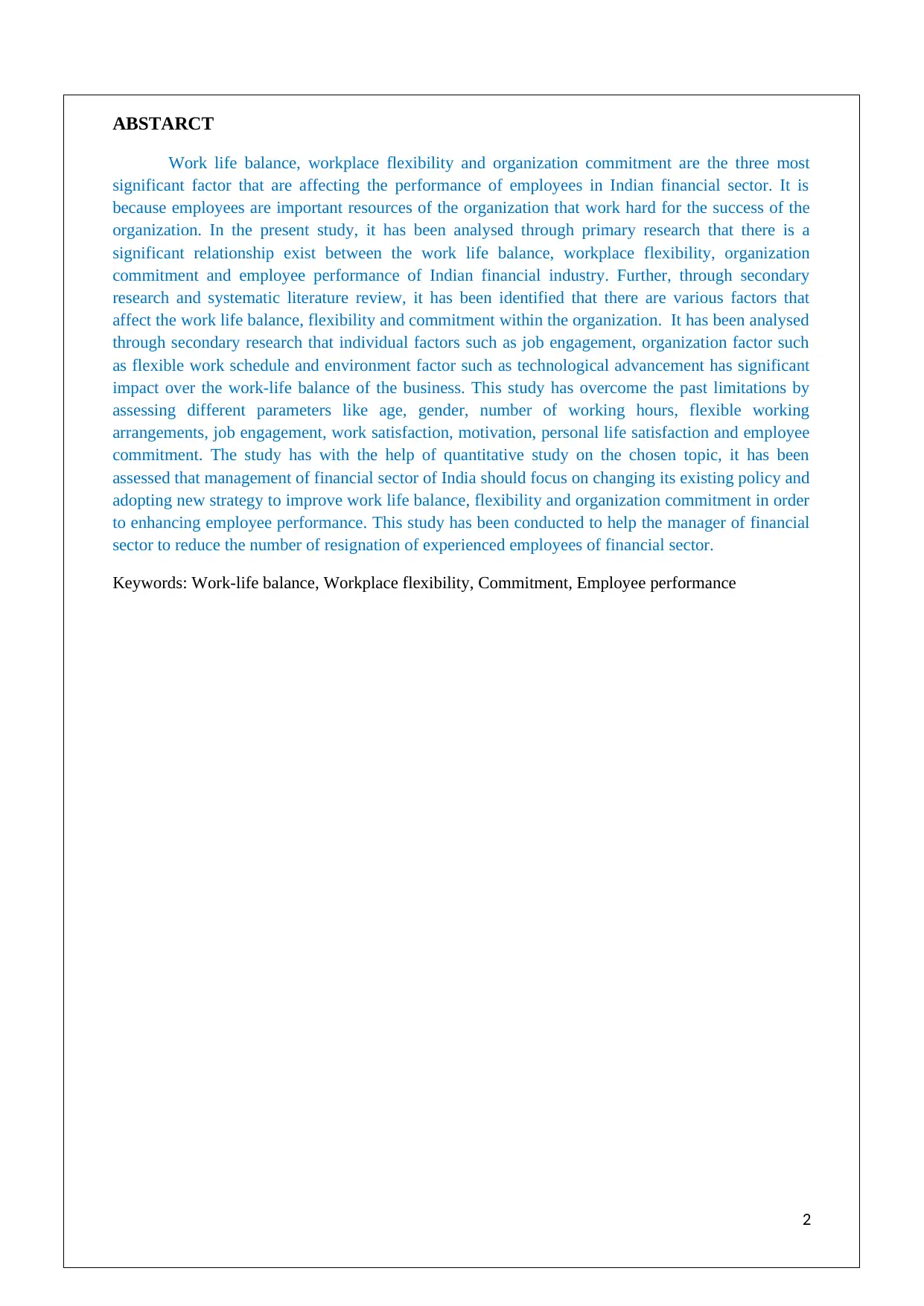
ABSTARCT
Work life balance, workplace flexibility and organization commitment are the three most
significant factor that are affecting the performance of employees in Indian financial sector. It is
because employees are important resources of the organization that work hard for the success of the
organization. In the present study, it has been analysed through primary research that there is a
significant relationship exist between the work life balance, workplace flexibility, organization
commitment and employee performance of Indian financial industry. Further, through secondary
research and systematic literature review, it has been identified that there are various factors that
affect the work life balance, flexibility and commitment within the organization. It has been analysed
through secondary research that individual factors such as job engagement, organization factor such
as flexible work schedule and environment factor such as technological advancement has significant
impact over the work-life balance of the business. This study has overcome the past limitations by
assessing different parameters like age, gender, number of working hours, flexible working
arrangements, job engagement, work satisfaction, motivation, personal life satisfaction and employee
commitment. The study has with the help of quantitative study on the chosen topic, it has been
assessed that management of financial sector of India should focus on changing its existing policy and
adopting new strategy to improve work life balance, flexibility and organization commitment in order
to enhancing employee performance. This study has been conducted to help the manager of financial
sector to reduce the number of resignation of experienced employees of financial sector.
Keywords: Work-life balance, Workplace flexibility, Commitment, Employee performance
2
Work life balance, workplace flexibility and organization commitment are the three most
significant factor that are affecting the performance of employees in Indian financial sector. It is
because employees are important resources of the organization that work hard for the success of the
organization. In the present study, it has been analysed through primary research that there is a
significant relationship exist between the work life balance, workplace flexibility, organization
commitment and employee performance of Indian financial industry. Further, through secondary
research and systematic literature review, it has been identified that there are various factors that
affect the work life balance, flexibility and commitment within the organization. It has been analysed
through secondary research that individual factors such as job engagement, organization factor such
as flexible work schedule and environment factor such as technological advancement has significant
impact over the work-life balance of the business. This study has overcome the past limitations by
assessing different parameters like age, gender, number of working hours, flexible working
arrangements, job engagement, work satisfaction, motivation, personal life satisfaction and employee
commitment. The study has with the help of quantitative study on the chosen topic, it has been
assessed that management of financial sector of India should focus on changing its existing policy and
adopting new strategy to improve work life balance, flexibility and organization commitment in order
to enhancing employee performance. This study has been conducted to help the manager of financial
sector to reduce the number of resignation of experienced employees of financial sector.
Keywords: Work-life balance, Workplace flexibility, Commitment, Employee performance
2
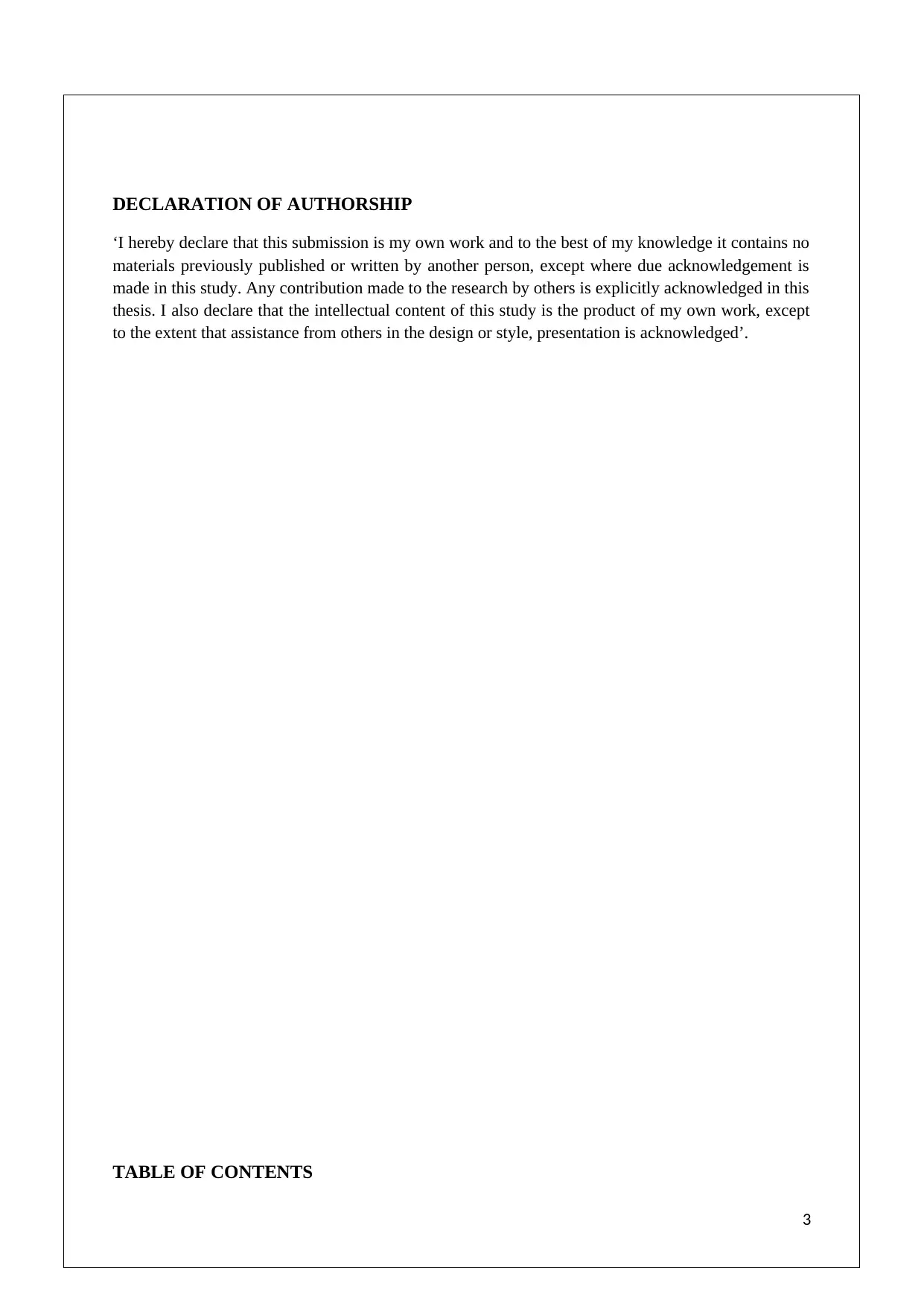
DECLARATION OF AUTHORSHIP
‘I hereby declare that this submission is my own work and to the best of my knowledge it contains no
materials previously published or written by another person, except where due acknowledgement is
made in this study. Any contribution made to the research by others is explicitly acknowledged in this
thesis. I also declare that the intellectual content of this study is the product of my own work, except
to the extent that assistance from others in the design or style, presentation is acknowledged’.
TABLE OF CONTENTS
3
‘I hereby declare that this submission is my own work and to the best of my knowledge it contains no
materials previously published or written by another person, except where due acknowledgement is
made in this study. Any contribution made to the research by others is explicitly acknowledged in this
thesis. I also declare that the intellectual content of this study is the product of my own work, except
to the extent that assistance from others in the design or style, presentation is acknowledged’.
TABLE OF CONTENTS
3
⊘ This is a preview!⊘
Do you want full access?
Subscribe today to unlock all pages.

Trusted by 1+ million students worldwide
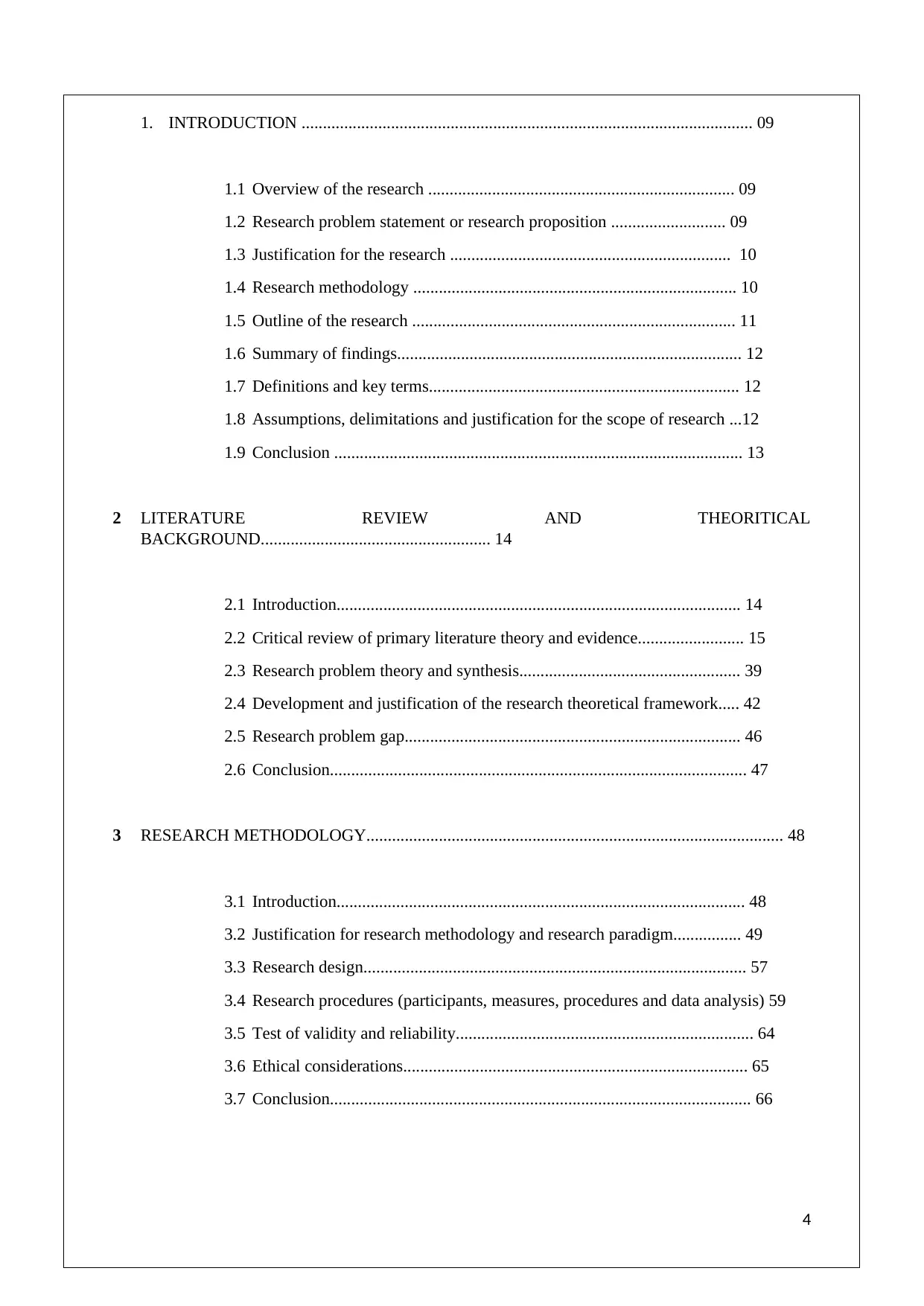
1. INTRODUCTION .......................................................................................................... 09
1.1 Overview of the research ........................................................................ 09
1.2 Research problem statement or research proposition ........................... 09
1.3 Justification for the research .................................................................. 10
1.4 Research methodology ............................................................................ 10
1.5 Outline of the research ............................................................................ 11
1.6 Summary of findings................................................................................. 12
1.7 Definitions and key terms......................................................................... 12
1.8 Assumptions, delimitations and justification for the scope of research ...12
1.9 Conclusion ................................................................................................ 13
2 LITERATURE REVIEW AND THEORITICAL
BACKGROUND...................................................... 14
2.1 Introduction............................................................................................... 14
2.2 Critical review of primary literature theory and evidence......................... 15
2.3 Research problem theory and synthesis.................................................... 39
2.4 Development and justification of the research theoretical framework..... 42
2.5 Research problem gap............................................................................... 46
2.6 Conclusion.................................................................................................. 47
3 RESEARCH METHODOLOGY.................................................................................................. 48
3.1 Introduction................................................................................................ 48
3.2 Justification for research methodology and research paradigm................ 49
3.3 Research design.......................................................................................... 57
3.4 Research procedures (participants, measures, procedures and data analysis) 59
3.5 Test of validity and reliability...................................................................... 64
3.6 Ethical considerations................................................................................. 65
3.7 Conclusion................................................................................................... 66
4
1.1 Overview of the research ........................................................................ 09
1.2 Research problem statement or research proposition ........................... 09
1.3 Justification for the research .................................................................. 10
1.4 Research methodology ............................................................................ 10
1.5 Outline of the research ............................................................................ 11
1.6 Summary of findings................................................................................. 12
1.7 Definitions and key terms......................................................................... 12
1.8 Assumptions, delimitations and justification for the scope of research ...12
1.9 Conclusion ................................................................................................ 13
2 LITERATURE REVIEW AND THEORITICAL
BACKGROUND...................................................... 14
2.1 Introduction............................................................................................... 14
2.2 Critical review of primary literature theory and evidence......................... 15
2.3 Research problem theory and synthesis.................................................... 39
2.4 Development and justification of the research theoretical framework..... 42
2.5 Research problem gap............................................................................... 46
2.6 Conclusion.................................................................................................. 47
3 RESEARCH METHODOLOGY.................................................................................................. 48
3.1 Introduction................................................................................................ 48
3.2 Justification for research methodology and research paradigm................ 49
3.3 Research design.......................................................................................... 57
3.4 Research procedures (participants, measures, procedures and data analysis) 59
3.5 Test of validity and reliability...................................................................... 64
3.6 Ethical considerations................................................................................. 65
3.7 Conclusion................................................................................................... 66
4
Paraphrase This Document
Need a fresh take? Get an instant paraphrase of this document with our AI Paraphraser

4 EVIDENCE AND DATA ANALYSIS.............................................................................................
67
4.1 Introduction................................................................................................. 67
4.2 Overview of data sample............................................................................. 67
4.3 Descriptive and Empirical Analysis............................................................... 69
4.4 Testing the theoretical framework...............................................................75
4.5 Results from the evidence for each research question................................ 75
4.6 Conclusion.................................................................................................... 86
5 CONCLUSIONS, FINDINGS, IMPLICATIONS AND
CONTRIBUTION........................................... 87
5.1 Introduction................................................................................................. 87
5.2 Conclusions and findings relating to each research question, issue, hypothesis or
proposition................................................................................................... 87
5.3 Implications of the research for theory........................................................ 88
5.4 Implications of the research for methodology........................................... 89
5.5 Implications of the research for leadership and management practice...... 89
5.6 Implications of the research for public policy............................................. 90
5.7 Limitations of the research......................................................................... 90
5.8 Future research directions arising from the research................................ 91
5.9 General conclusion..................................................................................... 92
6 BIBLIOGRAPHY...................................................................................................................... 93
7 APPENDICES......................................................................................................................... 10
5
67
4.1 Introduction................................................................................................. 67
4.2 Overview of data sample............................................................................. 67
4.3 Descriptive and Empirical Analysis............................................................... 69
4.4 Testing the theoretical framework...............................................................75
4.5 Results from the evidence for each research question................................ 75
4.6 Conclusion.................................................................................................... 86
5 CONCLUSIONS, FINDINGS, IMPLICATIONS AND
CONTRIBUTION........................................... 87
5.1 Introduction................................................................................................. 87
5.2 Conclusions and findings relating to each research question, issue, hypothesis or
proposition................................................................................................... 87
5.3 Implications of the research for theory........................................................ 88
5.4 Implications of the research for methodology........................................... 89
5.5 Implications of the research for leadership and management practice...... 89
5.6 Implications of the research for public policy............................................. 90
5.7 Limitations of the research......................................................................... 90
5.8 Future research directions arising from the research................................ 91
5.9 General conclusion..................................................................................... 92
6 BIBLIOGRAPHY...................................................................................................................... 93
7 APPENDICES......................................................................................................................... 10
5
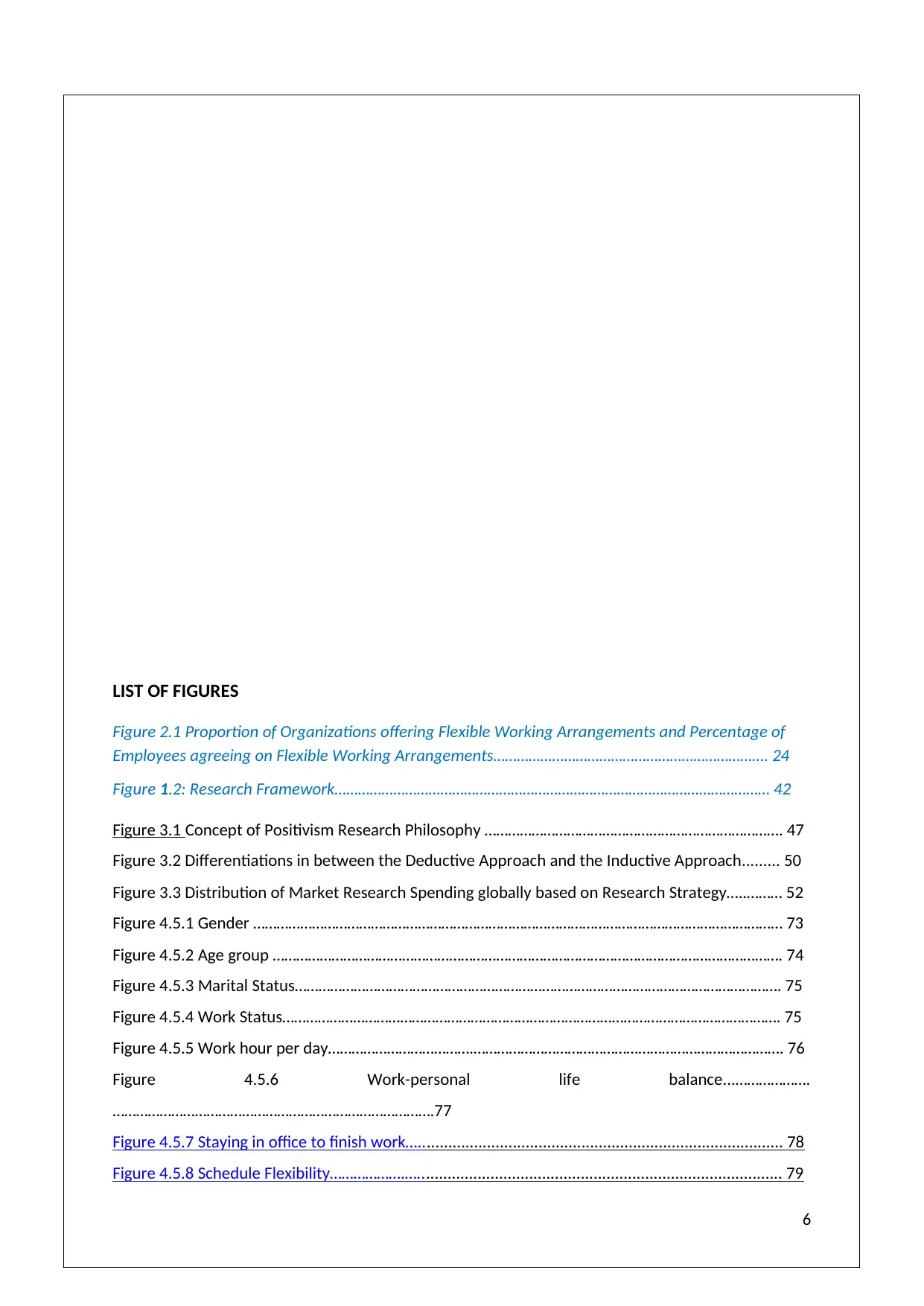
LIST OF FIGURES
Figure 2.1 Proportion of Organizations offering Flexible Working Arrangements and Percentage of
Employees agreeing on Flexible Working Arrangements……………………………………………………………. 24
Figure 1.2: Research Framework………………………………………………………………………………………………… 42
Figure 3.1 Concept of Positivism Research Philosophy …………………………………………………………………. 47
Figure 3.2 Differentiations in between the Deductive Approach and the Inductive Approach......... 50
Figure 3.3 Distribution of Market Research Spending globally based on Research Strategy…..……… 52
Figure 4.5.1 Gender ……………………………………………………………………………………………………………………… 73
Figure 4.5.2 Age group …………………………………………………………………………………………………………………. 74
Figure 4.5.3 Marital Status……………………………………………………………………………………………………………. 75
Figure 4.5.4 Work Status………………………………………………………………………………………………………………. 75
Figure 4.5.5 Work hour per day……………………………….……………………………………………………………………. 76
Figure 4.5.6 Work-personal life balance...……………….
……………………………………………………………………….77
Figure 4.5.7 Staying in office to finish work…..................................................................................... 78
Figure 4.5.8 Schedule Flexibility……………….…..................................................................................... 79
6
Figure 2.1 Proportion of Organizations offering Flexible Working Arrangements and Percentage of
Employees agreeing on Flexible Working Arrangements……………………………………………………………. 24
Figure 1.2: Research Framework………………………………………………………………………………………………… 42
Figure 3.1 Concept of Positivism Research Philosophy …………………………………………………………………. 47
Figure 3.2 Differentiations in between the Deductive Approach and the Inductive Approach......... 50
Figure 3.3 Distribution of Market Research Spending globally based on Research Strategy…..……… 52
Figure 4.5.1 Gender ……………………………………………………………………………………………………………………… 73
Figure 4.5.2 Age group …………………………………………………………………………………………………………………. 74
Figure 4.5.3 Marital Status……………………………………………………………………………………………………………. 75
Figure 4.5.4 Work Status………………………………………………………………………………………………………………. 75
Figure 4.5.5 Work hour per day……………………………….……………………………………………………………………. 76
Figure 4.5.6 Work-personal life balance...……………….
……………………………………………………………………….77
Figure 4.5.7 Staying in office to finish work…..................................................................................... 78
Figure 4.5.8 Schedule Flexibility……………….…..................................................................................... 79
6
⊘ This is a preview!⊘
Do you want full access?
Subscribe today to unlock all pages.

Trusted by 1+ million students worldwide
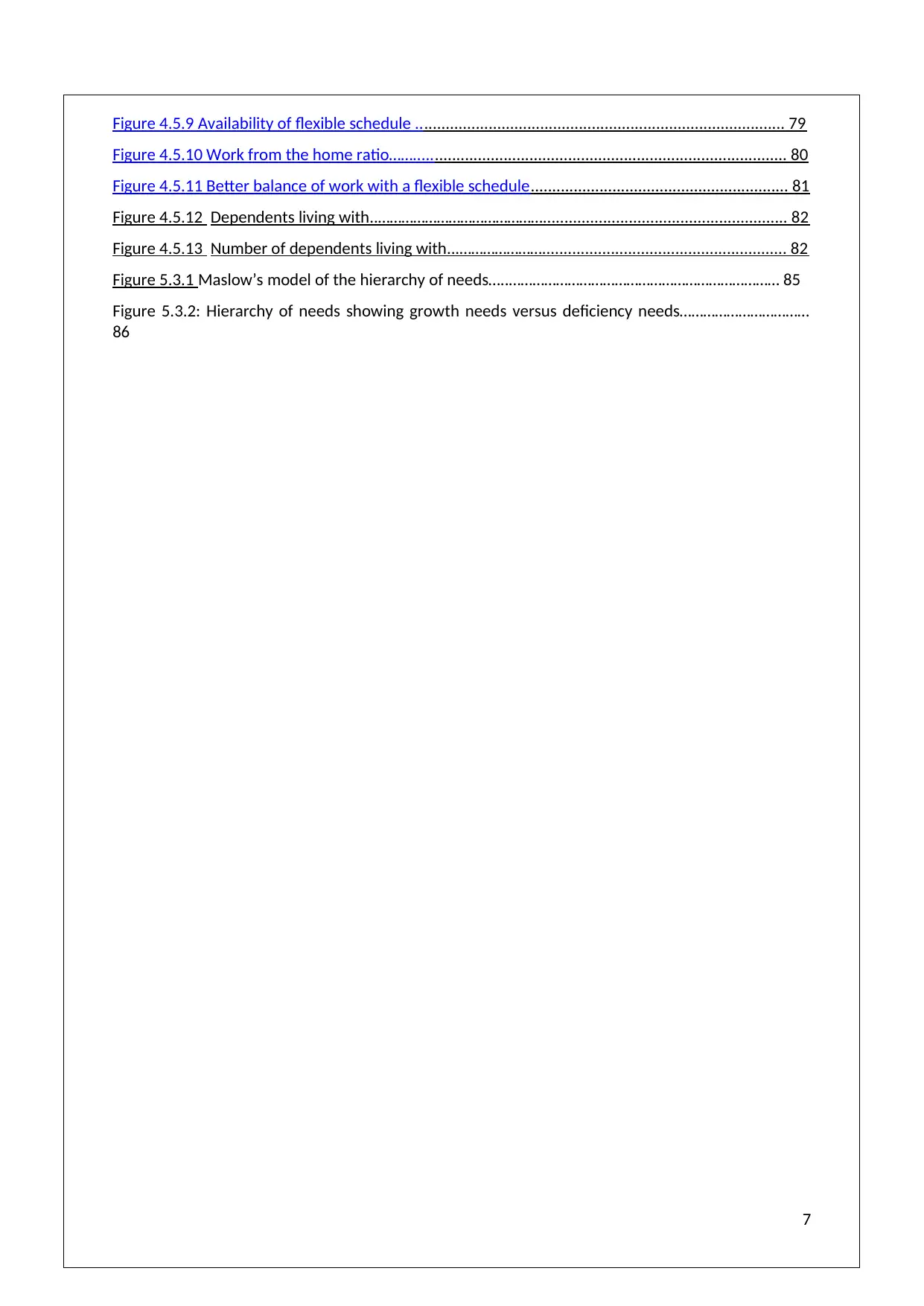
Figure 4.5.9 Availability of flexible schedule ...................................................................................... 79
Figure 4.5.10 Work from the home ratio……....................................................................................... 80
Figure 4.5.11 Better balance of work with a flexible schedule............................................................ 81
Figure 4.5.12 Dependents living with..……………………………………......................................................... 82
Figure 4.5.13 Number of dependents living with...…………………......................................................... 82
Figure 5.3.1 Maslow’s model of the hierarchy of needs…..…………………………………………………………… 85
Figure 5.3.2: Hierarchy of needs showing growth needs versus deficiency needs……………………………
86
7
Figure 4.5.10 Work from the home ratio……....................................................................................... 80
Figure 4.5.11 Better balance of work with a flexible schedule............................................................ 81
Figure 4.5.12 Dependents living with..……………………………………......................................................... 82
Figure 4.5.13 Number of dependents living with...…………………......................................................... 82
Figure 5.3.1 Maslow’s model of the hierarchy of needs…..…………………………………………………………… 85
Figure 5.3.2: Hierarchy of needs showing growth needs versus deficiency needs……………………………
86
7
Paraphrase This Document
Need a fresh take? Get an instant paraphrase of this document with our AI Paraphraser
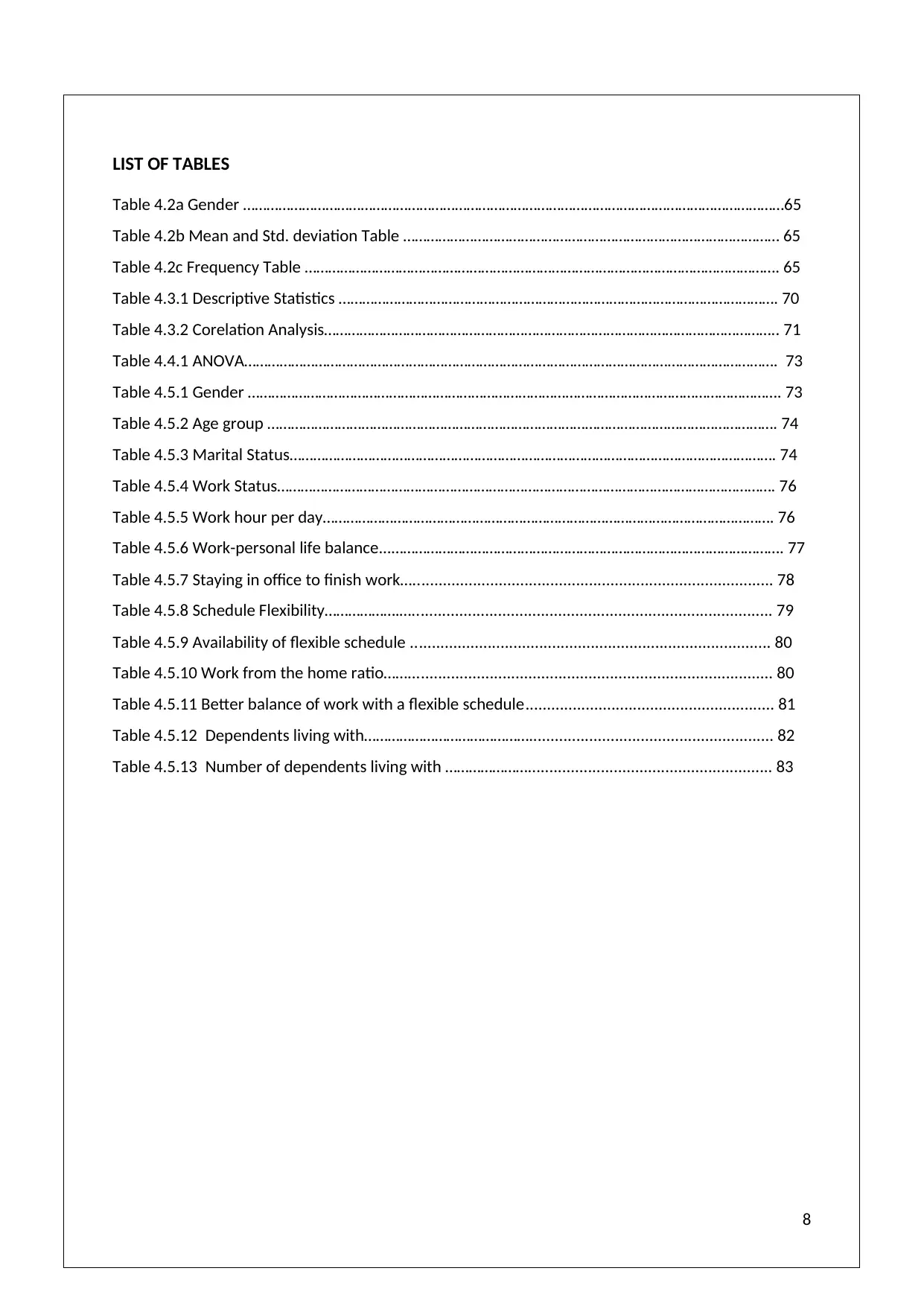
LIST OF TABLES
Table 4.2a Gender …………………………………………………………………………………………………………………………65
Table 4.2b Mean and Std. deviation Table …………………………………………………………………………………… 65
Table 4.2c Frequency Table …………………………………………………………………………………………………………. 65
Table 4.3.1 Descriptive Statistics …………………………………………………………………………………………………. 70
Table 4.3.2 Corelation Analysis…………………………………………………………………………………………………….. 71
Table 4.4.1 ANOVA………………………………………………………………………………………………………………………. 73
Table 4.5.1 Gender ………………………………………………………………………………………………………………………. 73
Table 4.5.2 Age group …………………………………………………………………………………………………………………. 74
Table 4.5.3 Marital Status……………………………………………………………………………………………………………. 74
Table 4.5.4 Work Status………………………………………………………………………………………………………………. 76
Table 4.5.5 Work hour per day……………………………………………………………………………………………………. 76
Table 4.5.6 Work-personal life balance...………………………………………………………………………………………. 77
Table 4.5.7 Staying in office to finish work….................................................................................... 78
Table 4.5.8 Schedule Flexibility……………….….................................................................................... 79
Table 4.5.9 Availability of flexible schedule .................................................................................... 80
Table 4.5.10 Work from the home ratio……..................................................................................... 80
Table 4.5.11 Better balance of work with a flexible schedule.......................................................... 81
Table 4.5.12 Dependents living with……………………………………......................................................... 82
Table 4.5.13 Number of dependents living with …………………......................................................... 83
8
Table 4.2a Gender …………………………………………………………………………………………………………………………65
Table 4.2b Mean and Std. deviation Table …………………………………………………………………………………… 65
Table 4.2c Frequency Table …………………………………………………………………………………………………………. 65
Table 4.3.1 Descriptive Statistics …………………………………………………………………………………………………. 70
Table 4.3.2 Corelation Analysis…………………………………………………………………………………………………….. 71
Table 4.4.1 ANOVA………………………………………………………………………………………………………………………. 73
Table 4.5.1 Gender ………………………………………………………………………………………………………………………. 73
Table 4.5.2 Age group …………………………………………………………………………………………………………………. 74
Table 4.5.3 Marital Status……………………………………………………………………………………………………………. 74
Table 4.5.4 Work Status………………………………………………………………………………………………………………. 76
Table 4.5.5 Work hour per day……………………………………………………………………………………………………. 76
Table 4.5.6 Work-personal life balance...………………………………………………………………………………………. 77
Table 4.5.7 Staying in office to finish work….................................................................................... 78
Table 4.5.8 Schedule Flexibility……………….….................................................................................... 79
Table 4.5.9 Availability of flexible schedule .................................................................................... 80
Table 4.5.10 Work from the home ratio……..................................................................................... 80
Table 4.5.11 Better balance of work with a flexible schedule.......................................................... 81
Table 4.5.12 Dependents living with……………………………………......................................................... 82
Table 4.5.13 Number of dependents living with …………………......................................................... 83
8
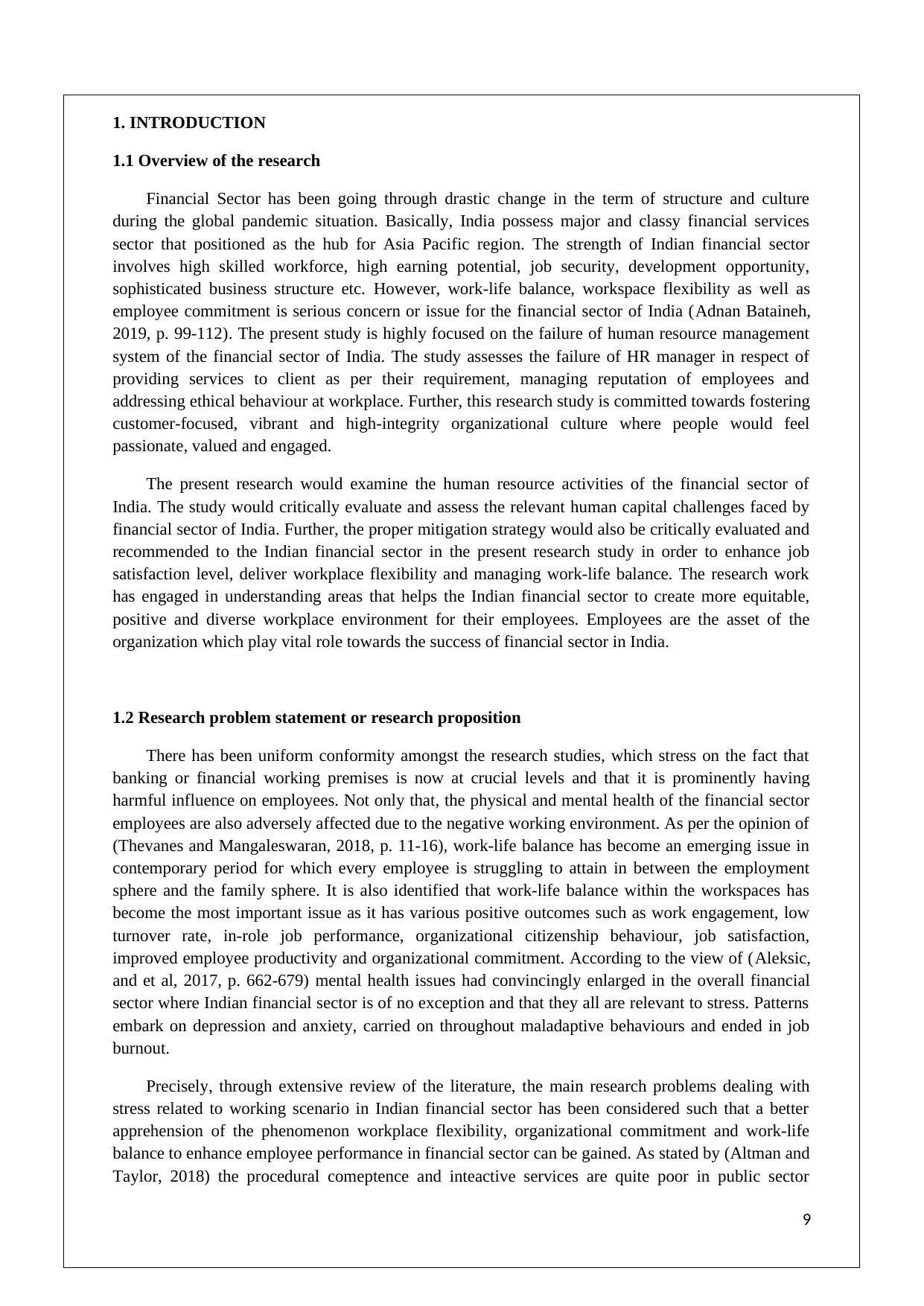
1. INTRODUCTION
1.1 Overview of the research
Financial Sector has been going through drastic change in the term of structure and culture
during the global pandemic situation. Basically, India possess major and classy financial services
sector that positioned as the hub for Asia Pacific region. The strength of Indian financial sector
involves high skilled workforce, high earning potential, job security, development opportunity,
sophisticated business structure etc. However, work-life balance, workspace flexibility as well as
employee commitment is serious concern or issue for the financial sector of India (Adnan Bataineh,
2019, p. 99-112). The present study is highly focused on the failure of human resource management
system of the financial sector of India. The study assesses the failure of HR manager in respect of
providing services to client as per their requirement, managing reputation of employees and
addressing ethical behaviour at workplace. Further, this research study is committed towards fostering
customer-focused, vibrant and high-integrity organizational culture where people would feel
passionate, valued and engaged.
The present research would examine the human resource activities of the financial sector of
India. The study would critically evaluate and assess the relevant human capital challenges faced by
financial sector of India. Further, the proper mitigation strategy would also be critically evaluated and
recommended to the Indian financial sector in the present research study in order to enhance job
satisfaction level, deliver workplace flexibility and managing work-life balance. The research work
has engaged in understanding areas that helps the Indian financial sector to create more equitable,
positive and diverse workplace environment for their employees. Employees are the asset of the
organization which play vital role towards the success of financial sector in India.
1.2 Research problem statement or research proposition
There has been uniform conformity amongst the research studies, which stress on the fact that
banking or financial working premises is now at crucial levels and that it is prominently having
harmful influence on employees. Not only that, the physical and mental health of the financial sector
employees are also adversely affected due to the negative working environment. As per the opinion of
(Thevanes and Mangaleswaran, 2018, p. 11-16), work-life balance has become an emerging issue in
contemporary period for which every employee is struggling to attain in between the employment
sphere and the family sphere. It is also identified that work-life balance within the workspaces has
become the most important issue as it has various positive outcomes such as work engagement, low
turnover rate, in-role job performance, organizational citizenship behaviour, job satisfaction,
improved employee productivity and organizational commitment. According to the view of (Aleksic,
and et al, 2017, p. 662-679) mental health issues had convincingly enlarged in the overall financial
sector where Indian financial sector is of no exception and that they all are relevant to stress. Patterns
embark on depression and anxiety, carried on throughout maladaptive behaviours and ended in job
burnout.
Precisely, through extensive review of the literature, the main research problems dealing with
stress related to working scenario in Indian financial sector has been considered such that a better
apprehension of the phenomenon workplace flexibility, organizational commitment and work-life
balance to enhance employee performance in financial sector can be gained. As stated by (Altman and
Taylor, 2018) the procedural comeptence and inteactive services are quite poor in public sector
9
1.1 Overview of the research
Financial Sector has been going through drastic change in the term of structure and culture
during the global pandemic situation. Basically, India possess major and classy financial services
sector that positioned as the hub for Asia Pacific region. The strength of Indian financial sector
involves high skilled workforce, high earning potential, job security, development opportunity,
sophisticated business structure etc. However, work-life balance, workspace flexibility as well as
employee commitment is serious concern or issue for the financial sector of India (Adnan Bataineh,
2019, p. 99-112). The present study is highly focused on the failure of human resource management
system of the financial sector of India. The study assesses the failure of HR manager in respect of
providing services to client as per their requirement, managing reputation of employees and
addressing ethical behaviour at workplace. Further, this research study is committed towards fostering
customer-focused, vibrant and high-integrity organizational culture where people would feel
passionate, valued and engaged.
The present research would examine the human resource activities of the financial sector of
India. The study would critically evaluate and assess the relevant human capital challenges faced by
financial sector of India. Further, the proper mitigation strategy would also be critically evaluated and
recommended to the Indian financial sector in the present research study in order to enhance job
satisfaction level, deliver workplace flexibility and managing work-life balance. The research work
has engaged in understanding areas that helps the Indian financial sector to create more equitable,
positive and diverse workplace environment for their employees. Employees are the asset of the
organization which play vital role towards the success of financial sector in India.
1.2 Research problem statement or research proposition
There has been uniform conformity amongst the research studies, which stress on the fact that
banking or financial working premises is now at crucial levels and that it is prominently having
harmful influence on employees. Not only that, the physical and mental health of the financial sector
employees are also adversely affected due to the negative working environment. As per the opinion of
(Thevanes and Mangaleswaran, 2018, p. 11-16), work-life balance has become an emerging issue in
contemporary period for which every employee is struggling to attain in between the employment
sphere and the family sphere. It is also identified that work-life balance within the workspaces has
become the most important issue as it has various positive outcomes such as work engagement, low
turnover rate, in-role job performance, organizational citizenship behaviour, job satisfaction,
improved employee productivity and organizational commitment. According to the view of (Aleksic,
and et al, 2017, p. 662-679) mental health issues had convincingly enlarged in the overall financial
sector where Indian financial sector is of no exception and that they all are relevant to stress. Patterns
embark on depression and anxiety, carried on throughout maladaptive behaviours and ended in job
burnout.
Precisely, through extensive review of the literature, the main research problems dealing with
stress related to working scenario in Indian financial sector has been considered such that a better
apprehension of the phenomenon workplace flexibility, organizational commitment and work-life
balance to enhance employee performance in financial sector can be gained. As stated by (Altman and
Taylor, 2018) the procedural comeptence and inteactive services are quite poor in public sector
9
⊘ This is a preview!⊘
Do you want full access?
Subscribe today to unlock all pages.

Trusted by 1+ million students worldwide
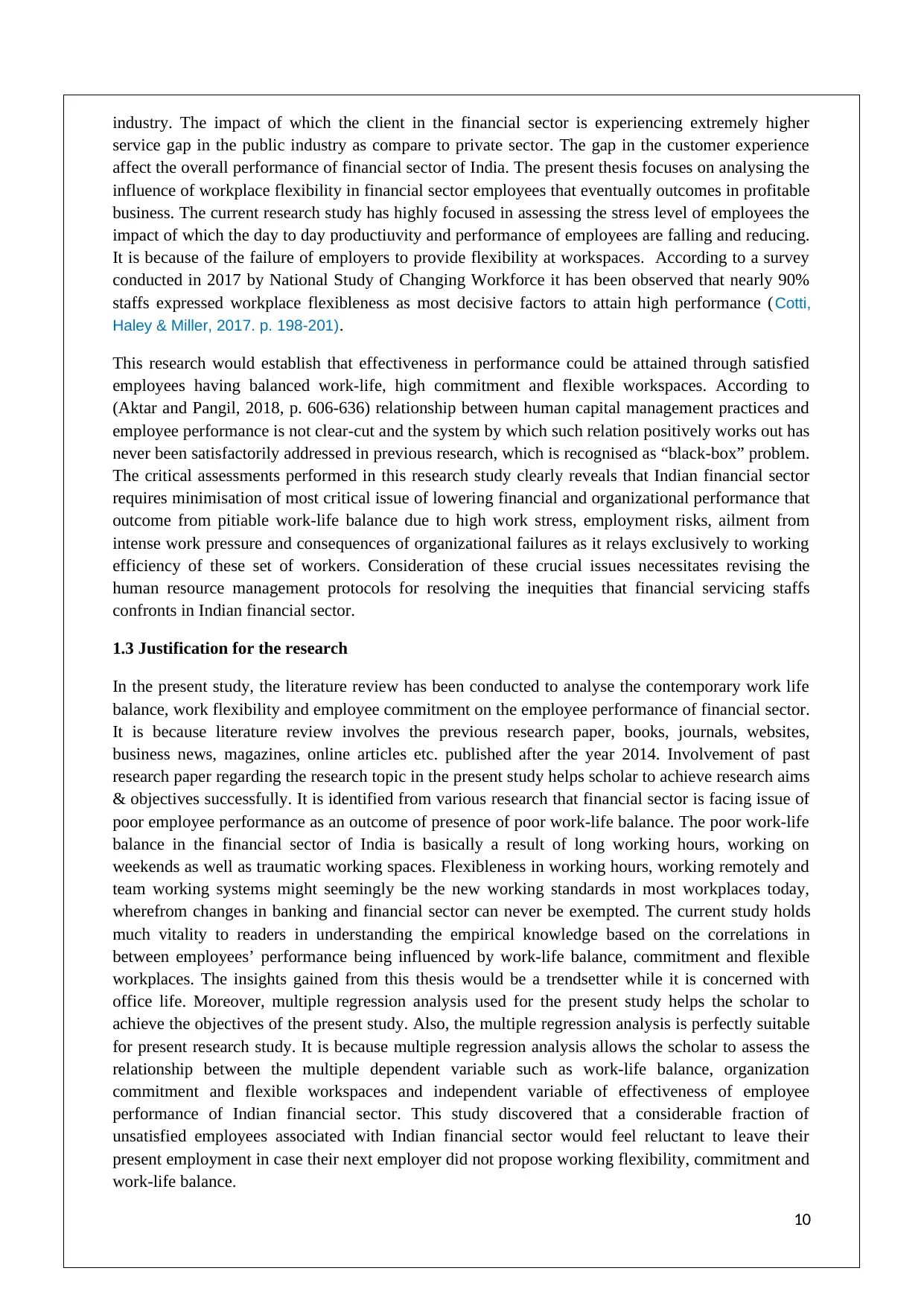
industry. The impact of which the client in the financial sector is experiencing extremely higher
service gap in the public industry as compare to private sector. The gap in the customer experience
affect the overall performance of financial sector of India. The present thesis focuses on analysing the
influence of workplace flexibility in financial sector employees that eventually outcomes in profitable
business. The current research study has highly focused in assessing the stress level of employees the
impact of which the day to day productiuvity and performance of employees are falling and reducing.
It is because of the failure of employers to provide flexibility at workspaces. According to a survey
conducted in 2017 by National Study of Changing Workforce it has been observed that nearly 90%
staffs expressed workplace flexibleness as most decisive factors to attain high performance (Cotti,
Haley & Miller, 2017. p. 198-201).
This research would establish that effectiveness in performance could be attained through satisfied
employees having balanced work-life, high commitment and flexible workspaces. According to
(Aktar and Pangil, 2018, p. 606-636) relationship between human capital management practices and
employee performance is not clear-cut and the system by which such relation positively works out has
never been satisfactorily addressed in previous research, which is recognised as “black-box” problem.
The critical assessments performed in this research study clearly reveals that Indian financial sector
requires minimisation of most critical issue of lowering financial and organizational performance that
outcome from pitiable work-life balance due to high work stress, employment risks, ailment from
intense work pressure and consequences of organizational failures as it relays exclusively to working
efficiency of these set of workers. Consideration of these crucial issues necessitates revising the
human resource management protocols for resolving the inequities that financial servicing staffs
confronts in Indian financial sector.
1.3 Justification for the research
In the present study, the literature review has been conducted to analyse the contemporary work life
balance, work flexibility and employee commitment on the employee performance of financial sector.
It is because literature review involves the previous research paper, books, journals, websites,
business news, magazines, online articles etc. published after the year 2014. Involvement of past
research paper regarding the research topic in the present study helps scholar to achieve research aims
& objectives successfully. It is identified from various research that financial sector is facing issue of
poor employee performance as an outcome of presence of poor work-life balance. The poor work-life
balance in the financial sector of India is basically a result of long working hours, working on
weekends as well as traumatic working spaces. Flexibleness in working hours, working remotely and
team working systems might seemingly be the new working standards in most workplaces today,
wherefrom changes in banking and financial sector can never be exempted. The current study holds
much vitality to readers in understanding the empirical knowledge based on the correlations in
between employees’ performance being influenced by work-life balance, commitment and flexible
workplaces. The insights gained from this thesis would be a trendsetter while it is concerned with
office life. Moreover, multiple regression analysis used for the present study helps the scholar to
achieve the objectives of the present study. Also, the multiple regression analysis is perfectly suitable
for present research study. It is because multiple regression analysis allows the scholar to assess the
relationship between the multiple dependent variable such as work-life balance, organization
commitment and flexible workspaces and independent variable of effectiveness of employee
performance of Indian financial sector. This study discovered that a considerable fraction of
unsatisfied employees associated with Indian financial sector would feel reluctant to leave their
present employment in case their next employer did not propose working flexibility, commitment and
work-life balance.
10
service gap in the public industry as compare to private sector. The gap in the customer experience
affect the overall performance of financial sector of India. The present thesis focuses on analysing the
influence of workplace flexibility in financial sector employees that eventually outcomes in profitable
business. The current research study has highly focused in assessing the stress level of employees the
impact of which the day to day productiuvity and performance of employees are falling and reducing.
It is because of the failure of employers to provide flexibility at workspaces. According to a survey
conducted in 2017 by National Study of Changing Workforce it has been observed that nearly 90%
staffs expressed workplace flexibleness as most decisive factors to attain high performance (Cotti,
Haley & Miller, 2017. p. 198-201).
This research would establish that effectiveness in performance could be attained through satisfied
employees having balanced work-life, high commitment and flexible workspaces. According to
(Aktar and Pangil, 2018, p. 606-636) relationship between human capital management practices and
employee performance is not clear-cut and the system by which such relation positively works out has
never been satisfactorily addressed in previous research, which is recognised as “black-box” problem.
The critical assessments performed in this research study clearly reveals that Indian financial sector
requires minimisation of most critical issue of lowering financial and organizational performance that
outcome from pitiable work-life balance due to high work stress, employment risks, ailment from
intense work pressure and consequences of organizational failures as it relays exclusively to working
efficiency of these set of workers. Consideration of these crucial issues necessitates revising the
human resource management protocols for resolving the inequities that financial servicing staffs
confronts in Indian financial sector.
1.3 Justification for the research
In the present study, the literature review has been conducted to analyse the contemporary work life
balance, work flexibility and employee commitment on the employee performance of financial sector.
It is because literature review involves the previous research paper, books, journals, websites,
business news, magazines, online articles etc. published after the year 2014. Involvement of past
research paper regarding the research topic in the present study helps scholar to achieve research aims
& objectives successfully. It is identified from various research that financial sector is facing issue of
poor employee performance as an outcome of presence of poor work-life balance. The poor work-life
balance in the financial sector of India is basically a result of long working hours, working on
weekends as well as traumatic working spaces. Flexibleness in working hours, working remotely and
team working systems might seemingly be the new working standards in most workplaces today,
wherefrom changes in banking and financial sector can never be exempted. The current study holds
much vitality to readers in understanding the empirical knowledge based on the correlations in
between employees’ performance being influenced by work-life balance, commitment and flexible
workplaces. The insights gained from this thesis would be a trendsetter while it is concerned with
office life. Moreover, multiple regression analysis used for the present study helps the scholar to
achieve the objectives of the present study. Also, the multiple regression analysis is perfectly suitable
for present research study. It is because multiple regression analysis allows the scholar to assess the
relationship between the multiple dependent variable such as work-life balance, organization
commitment and flexible workspaces and independent variable of effectiveness of employee
performance of Indian financial sector. This study discovered that a considerable fraction of
unsatisfied employees associated with Indian financial sector would feel reluctant to leave their
present employment in case their next employer did not propose working flexibility, commitment and
work-life balance.
10
Paraphrase This Document
Need a fresh take? Get an instant paraphrase of this document with our AI Paraphraser

1.4 Research methodology
Developing the research and properly relating it with pre-existing knowledge ensures the building
block of numerous academic research activities, which further extends essentiality of selecting proper
research methods to be applied while studying. The positivism research approach entails that only
true knowledge is always empirical and focused on instantaneous observational data (Marsonet, 2019,
p. 32-36). This approach is rightfully chosen, as quantitative data based on employees in the financial
industry in India has been collected for revealing trends and patterns in Indian financial sector.
Deductive reasoning method has been selected as the research topic initiates with generation of
specific hypotheses based on the relationships between three variables that are work-life balance,
flexible workplace and organizational commitment, thereafter assess the probability within those
hypotheses for reaching the ultimate conclusion that these aforementioned variables prominently
impact on effectiveness of employee performance in financial sector. In this research, secondary data
collection methods have been applied for gaining fundamental knowledge about the research topic
and concerned variables.
On the other hand, primary data collection method has been also used by the scholar in order to
collect the relevant and reliable facts, figures and information about Indian financial sector. For this,
the scholar has selected 53 employees of Indian financial sector and collect the data through survey
method via mean of questionnaire. As opined by (Raj, 2020, p. 113) primary data seems to be more
scientific, accurate and costlier. Based on quantitative analysis it has been better to assess the human
resource management functionalities that are associated with enhancing employees’ performance.
Totality of 53 respondents chosen by applying random probabilistic sampling method has been
surveyed through Survey Monkey. During analysis of those data, meaningful statistical techniques
have been applied. The purpose of using mathematical calculations has been to serve as an effective
tool that can properly study the changes in science world. Precisely, collected data from the survey
with the help of questionnaire format has been accurately analysed using multiple regression analysis
technique in latest version of SPSS software such as 28. The outcomes gained have been helpful in
verifying the predetermined hypotheses and understanding the correlations in between the concerned
variables.
1.5 Research Outline
The study has been based on the criticalities associated with the financial sector in India. Through
analysing the concerning issues in terms of commitment, workplace flexibility and work-life balance,
a strategic projection has been provided that would facilitate the financial sector employees and
readers in proper revival of the contemporary financial sector in India. The appraisal shown through
this thesis has been done with special reference to Indian financial sector. In due research process for
achieving the research aim specific research objectives followed by research questions and research
hypotheses has been generated. While addressing those, the overall research has been performed.
1.5a Research Aim
The present research has aimed to conduct a proper assessment on contemporary work-life balance,
work-place flexibility and commitment to employee performance in financial sector in India.
1.5b Research Objectives
1. To examine the personal and professional work-life balance on employee performance in the
financial sector
11
Developing the research and properly relating it with pre-existing knowledge ensures the building
block of numerous academic research activities, which further extends essentiality of selecting proper
research methods to be applied while studying. The positivism research approach entails that only
true knowledge is always empirical and focused on instantaneous observational data (Marsonet, 2019,
p. 32-36). This approach is rightfully chosen, as quantitative data based on employees in the financial
industry in India has been collected for revealing trends and patterns in Indian financial sector.
Deductive reasoning method has been selected as the research topic initiates with generation of
specific hypotheses based on the relationships between three variables that are work-life balance,
flexible workplace and organizational commitment, thereafter assess the probability within those
hypotheses for reaching the ultimate conclusion that these aforementioned variables prominently
impact on effectiveness of employee performance in financial sector. In this research, secondary data
collection methods have been applied for gaining fundamental knowledge about the research topic
and concerned variables.
On the other hand, primary data collection method has been also used by the scholar in order to
collect the relevant and reliable facts, figures and information about Indian financial sector. For this,
the scholar has selected 53 employees of Indian financial sector and collect the data through survey
method via mean of questionnaire. As opined by (Raj, 2020, p. 113) primary data seems to be more
scientific, accurate and costlier. Based on quantitative analysis it has been better to assess the human
resource management functionalities that are associated with enhancing employees’ performance.
Totality of 53 respondents chosen by applying random probabilistic sampling method has been
surveyed through Survey Monkey. During analysis of those data, meaningful statistical techniques
have been applied. The purpose of using mathematical calculations has been to serve as an effective
tool that can properly study the changes in science world. Precisely, collected data from the survey
with the help of questionnaire format has been accurately analysed using multiple regression analysis
technique in latest version of SPSS software such as 28. The outcomes gained have been helpful in
verifying the predetermined hypotheses and understanding the correlations in between the concerned
variables.
1.5 Research Outline
The study has been based on the criticalities associated with the financial sector in India. Through
analysing the concerning issues in terms of commitment, workplace flexibility and work-life balance,
a strategic projection has been provided that would facilitate the financial sector employees and
readers in proper revival of the contemporary financial sector in India. The appraisal shown through
this thesis has been done with special reference to Indian financial sector. In due research process for
achieving the research aim specific research objectives followed by research questions and research
hypotheses has been generated. While addressing those, the overall research has been performed.
1.5a Research Aim
The present research has aimed to conduct a proper assessment on contemporary work-life balance,
work-place flexibility and commitment to employee performance in financial sector in India.
1.5b Research Objectives
1. To examine the personal and professional work-life balance on employee performance in the
financial sector
11
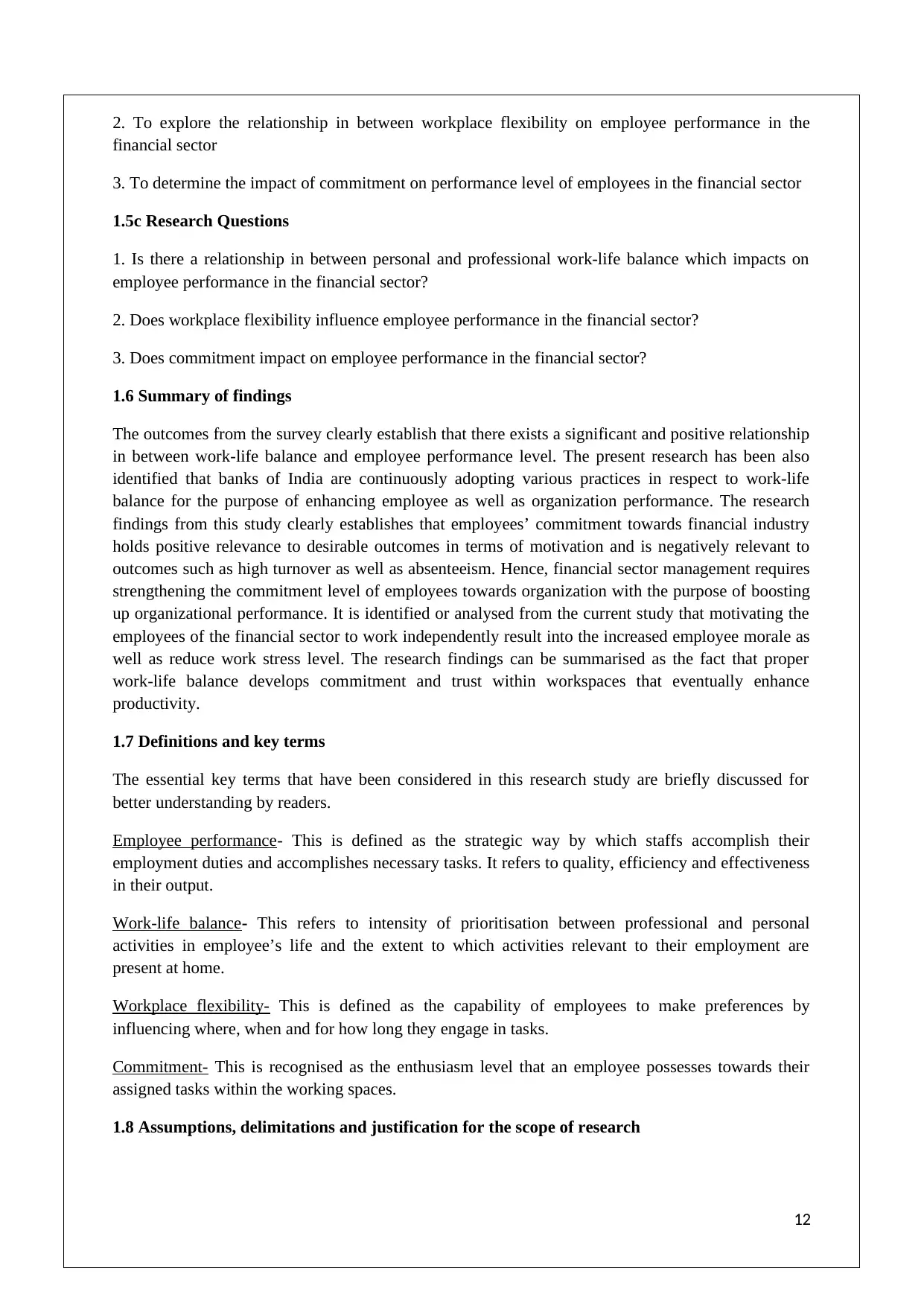
2. To explore the relationship in between workplace flexibility on employee performance in the
financial sector
3. To determine the impact of commitment on performance level of employees in the financial sector
1.5c Research Questions
1. Is there a relationship in between personal and professional work-life balance which impacts on
employee performance in the financial sector?
2. Does workplace flexibility influence employee performance in the financial sector?
3. Does commitment impact on employee performance in the financial sector?
1.6 Summary of findings
The outcomes from the survey clearly establish that there exists a significant and positive relationship
in between work-life balance and employee performance level. The present research has been also
identified that banks of India are continuously adopting various practices in respect to work-life
balance for the purpose of enhancing employee as well as organization performance. The research
findings from this study clearly establishes that employees’ commitment towards financial industry
holds positive relevance to desirable outcomes in terms of motivation and is negatively relevant to
outcomes such as high turnover as well as absenteeism. Hence, financial sector management requires
strengthening the commitment level of employees towards organization with the purpose of boosting
up organizational performance. It is identified or analysed from the current study that motivating the
employees of the financial sector to work independently result into the increased employee morale as
well as reduce work stress level. The research findings can be summarised as the fact that proper
work-life balance develops commitment and trust within workspaces that eventually enhance
productivity.
1.7 Definitions and key terms
The essential key terms that have been considered in this research study are briefly discussed for
better understanding by readers.
Employee performance- This is defined as the strategic way by which staffs accomplish their
employment duties and accomplishes necessary tasks. It refers to quality, efficiency and effectiveness
in their output.
Work-life balance- This refers to intensity of prioritisation between professional and personal
activities in employee’s life and the extent to which activities relevant to their employment are
present at home.
Workplace flexibility- This is defined as the capability of employees to make preferences by
influencing where, when and for how long they engage in tasks.
Commitment- This is recognised as the enthusiasm level that an employee possesses towards their
assigned tasks within the working spaces.
1.8 Assumptions, delimitations and justification for the scope of research
12
financial sector
3. To determine the impact of commitment on performance level of employees in the financial sector
1.5c Research Questions
1. Is there a relationship in between personal and professional work-life balance which impacts on
employee performance in the financial sector?
2. Does workplace flexibility influence employee performance in the financial sector?
3. Does commitment impact on employee performance in the financial sector?
1.6 Summary of findings
The outcomes from the survey clearly establish that there exists a significant and positive relationship
in between work-life balance and employee performance level. The present research has been also
identified that banks of India are continuously adopting various practices in respect to work-life
balance for the purpose of enhancing employee as well as organization performance. The research
findings from this study clearly establishes that employees’ commitment towards financial industry
holds positive relevance to desirable outcomes in terms of motivation and is negatively relevant to
outcomes such as high turnover as well as absenteeism. Hence, financial sector management requires
strengthening the commitment level of employees towards organization with the purpose of boosting
up organizational performance. It is identified or analysed from the current study that motivating the
employees of the financial sector to work independently result into the increased employee morale as
well as reduce work stress level. The research findings can be summarised as the fact that proper
work-life balance develops commitment and trust within workspaces that eventually enhance
productivity.
1.7 Definitions and key terms
The essential key terms that have been considered in this research study are briefly discussed for
better understanding by readers.
Employee performance- This is defined as the strategic way by which staffs accomplish their
employment duties and accomplishes necessary tasks. It refers to quality, efficiency and effectiveness
in their output.
Work-life balance- This refers to intensity of prioritisation between professional and personal
activities in employee’s life and the extent to which activities relevant to their employment are
present at home.
Workplace flexibility- This is defined as the capability of employees to make preferences by
influencing where, when and for how long they engage in tasks.
Commitment- This is recognised as the enthusiasm level that an employee possesses towards their
assigned tasks within the working spaces.
1.8 Assumptions, delimitations and justification for the scope of research
12
⊘ This is a preview!⊘
Do you want full access?
Subscribe today to unlock all pages.

Trusted by 1+ million students worldwide
1 out of 27
Related Documents
Your All-in-One AI-Powered Toolkit for Academic Success.
+13062052269
info@desklib.com
Available 24*7 on WhatsApp / Email
![[object Object]](/_next/static/media/star-bottom.7253800d.svg)
Unlock your academic potential
Copyright © 2020–2025 A2Z Services. All Rights Reserved. Developed and managed by ZUCOL.





